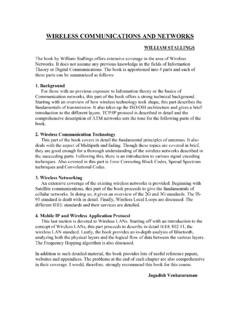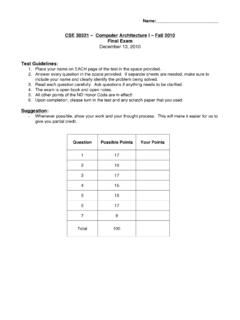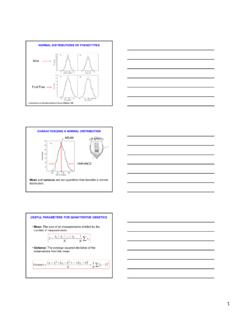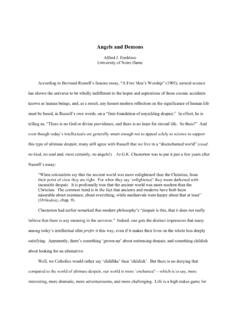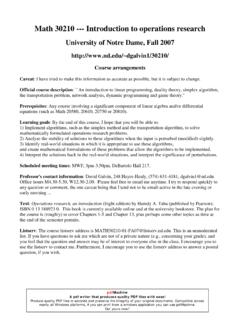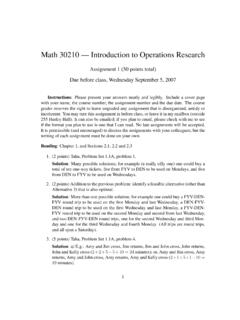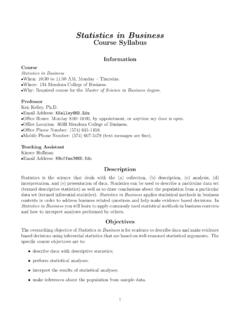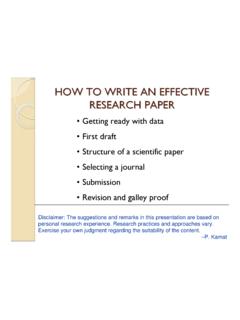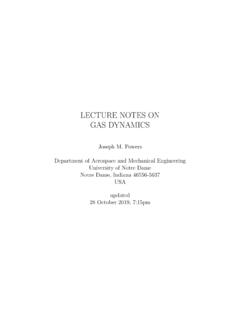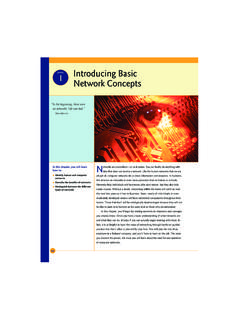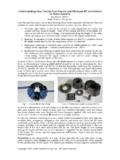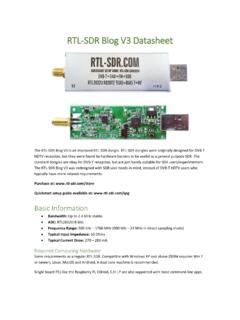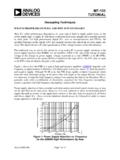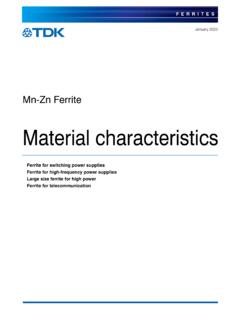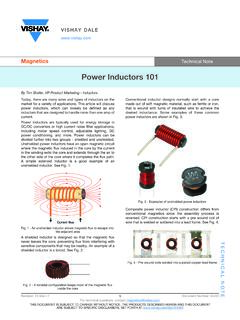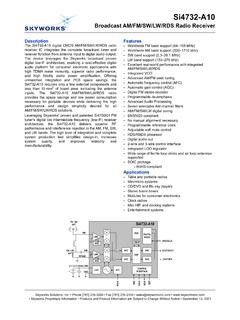Transcription of CHAPTER 11: METAL ALLOYS APPLICATIONS AND PROCESSING
1 ISSUES TO How are METAL ALLOYS classified and how are they used? What are some of the common fabrication techniques? How do properties vary throughout a piece of material that has been quenched, for example? How can properties be modified by post heat treatment? CHAPTER 11: METAL ALLOYS APPLICATIONS AND PROCESSING Classifications of METAL ALLOYS Fe 3 C cementite METAL ALLOYS Steels Ferrous Nonferrous Cast Irons Cu Al Mg Ti < wt%C 1600 1400 1200 1000 800 6 00 4 00 0 1 2 3 4 5 6 L g austenite g +L g +Fe 3 C a ferrite a +Fe 3 C L+Fe 3 C d (Fe) Carbon concentration, C Eutectic Eutectoid 727 C 1148 C T( C) Steels < Cast Irons tic Ferrous ALLOYS .
2 Iron is the prime constituent Ferrous ALLOYS are relatively inexpensive and extremely versatile Thus these ALLOYS are wide spread engineering materials ALLOYS that are so brittle that forming by deformation is not possible ordinary are cast ALLOYS that are amenable to mechanical deformation are termed wrought Heat-treatable - are ALLOYS whose mechanical strength can be improved by heat-treatment ( precipitation hardening or martensitic transformations). Some definitions: Name: High Alloy Low carbon < Medium-carbon High carbon APPLICATIONS : auto struc.
3 Sheet bridges towers press. vessels crank shafts bolts hammers blades pistons gears wear APPLICATIONS wear APPLICATIONS drills saws dies high T APPLICATIONS turbines furnaces corrosion resistant Example (ASTM#): 1010 A633 1040 4340 1095 4190 304 Additions: none Cu,V,Ni,Mo none Cr, Ni,Mo none Cr, V,Mo,W Cr, Ni, Mo Hardenability 0 + + ++ ++ +++ 0 TS - 0 + ++ + ++ 0 EL + + 0 - - -- ++ increasing strength, cost, decreasing ductility Classification of Steels Low Alloy Plain Plain Plain High strength Heat treatable Tool Stainless 10-plane or C CAST IRON The cast irons are the ferrous ALLOYS with greater that wt.
4 % carbon, but typically contain wt. % of C as well as other alloying elements, such as silicon (~3 ) which controls kinetics of carbide formation Fe 3 C cementite wt%C 1600 1400 1200 1000 6 00 4 00 0 1 2 3 4 5 6 L g austenite g +L g +Fe 3 C a +Fe 3 C L+Fe 3 C d (Fe) Carbon concentration, C Eutectic Eutectoid 727 C 1148 C T( C) wt%C These ALLOYS have relatively low melting points (1150-1300 C), do not formed undesirable surface films when poured, and undergo moderate shrinkage during solidification.
5 Thus can be easily melted and amenable to casting There are four general types of cast irons: 1. White iron has a characteristics white, crystalline fracture surface. Large amount of Fe3C are formed during casting, giving hard brittle material 2. Gray iron has a gray fracture surface with finely faced structure. A large Si content (2-3 wt. %) promotes C flakes precipitation rather than carbide 3. Ductile iron: small addition ( ) of Mg to gray iron changes the flake C microstructure to spheroidal that increases (by factor ~20) steel ductility 4.
6 Malleable iron: traditional form of cast iron with reasonable ductility. First cast to white iron and then heat-treated to produce nodular graphite precipitates. Equilibrium and Metastable Phases Cementite (Fe3C) is a metastable phase and after long term treatment decompose to form a-ferrite and carbon: Fe3C 3Fe(S) + C(graphite) Slow cooling and addition of some elements ( Si) promote graphite formation Properties of cast irons are defined by the amount and microstructure of existing carbon phase. Equilibrium iron-carbon phase diagram White and Malleable Cast Irons The low-silicon cast irons (< ), produced under rapid cooling conditions Microstructure: most of cementite Properties: extremely hard very but brittle White iron is an intermediate for the production of malleable iron White iron: light Fe3C regions surrounded by pearlite Malleable iron: dark graphite rosettes in a-Fe matrix Gray and Ductile Cast Irons The gray irons contain of Si Microstructure.
7 Flake shape graphite in ferrite matrix Properties: relatively weak and brittle in tension BUT very effective in damping vibrational energy an high resistive to wear!! Gray iron: Dark graphite flakes In a-Fe matrix Ductile iron: dark graphite nodules in a-Fe matrix Ductile (or Nodular) iron : small addition of Mg or/and Ce to the gray iron composition before casting Microstructure: Nodular or spherical-like graphite structure in pearlite or ferric matrix Properties: Significant increase in material ductility !
8 ! APPLICATIONS : valves, pump bodies, gears and other auto and machine components. RAPIDLY SOLIDIFIED FERROUS ALLOYS Eutectic compositions that permit cooling to a glass transition temperature at practically reachable quench rate (105 and 106 C /s) - rapidly solidified ALLOYS Boron, B, rather than carbon is a primary alloying element for amorphous ferrous ALLOYS Properties: (a) absence of grain boundaries easy magnetized materials (b) extremely fine structure exceptional strength and toughness Compositions (wt.)
9 %) B Si Cr Ni Mo P 20 10 28 6 10 6 40 6 14 Some Amorphous Ferrous ALLOYS Nonferrous ALLOYS Cu ALLOYS Brass : Zn is prime impurity (costume jewelry, coins, corrosion resistant) Bronze : Sn, Al, Si, Ni are prime impurities (bushings, landing gear) Cu-Be precipitation-hardened for strength Al ALLOYS -lower r : -Cu, Mg, Si, Mn, Zn additions -solid solutions or precipitation strengthened (structural aircraft parts & packaging) Mg ALLOYS -very low r : -ignites easily - aircraft, missiles Refractory metals -high melting T -Nb, Mo, W, Ta Noble metals -Ag, Au, Pt - oxidation/corrosion resistant Ti ALLOYS -lower r : vs for steel -reactive at high T -space APPLICATIONS NONFERROUS ALLOYS Cooper and its ALLOYS Cooper: soft and ductile; unlimited cold-work capacity, but difficult to machine.
10 Cold-working and solid solution alloying Main types of Copper ALLOYS : Brasses: zinc (Zn) is main substitutional impurity; APPLICATIONS : cartridges, auto-radiator. Musical instruments, coins Bronzes: tin (Sn), aluminum (Al), Silicon (Si) and nickel (Ni); stronger than brasses with high degree of corrosion resistance Heat-treated (precipitation hardening) Cu- ALLOYS : beryllium coopers; relatively high strength, excellent electrical and corrosion properties BUT expensive; APPLICATIONS : jet aircraft landing gear bearing, surgical and dental instruments.
